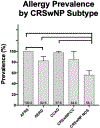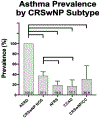Central compartment atopic disease: prevalence of allergy and asthma compared with other subtypes of chronic rhinosinusitis with nasal polyps
- PMID: 31600866
- PMCID: PMC7185061
- DOI: 10.1002/alr.22454
Central compartment atopic disease: prevalence of allergy and asthma compared with other subtypes of chronic rhinosinusitis with nasal polyps
Abstract
Background: Central compartment atopic disease (CCAD) is a recently described variant of chronic rhinosinusitis with nasal polyp (CRSwNP) associated with inhalant allergy. An association with asthma was noted to be uncommon within our clinical practice. The purpose of this study was to determine allergy and asthma prevalence in CCAD and other CRSwNP subtypes.
Methods: A retrospective analysis at a tertiary care institution was performed over the period from 2015 to 2019. CRSwNP was grouped into the following subtypes: allergic fungal rhinosinusitis (AFRS); aspirin-exacerbated respiratory disease (AERD); CCAD; and CRSwNP not otherwise specified (CRSwNP NOS). Patients with sinonasal polyps and concomitant polypoid disease in the central compartment (CRSwNP/CC) were analyzed as a separate cohort for the purpose of this study. Prevalence of allergy and asthma was compared between groups.
Results: Three hundred fifty-six patients were included. CRSwNP NOS was the most common subtype (37.1%) and CRSwNP/CC was the least common (3.7%), with other CRS subtypes ranging between 11.5% and 24.2%. Asthma prevalence was highest in AERD (100%) and CRSwNP NOS (37.1%), but substantially lower in AFRS (19.0%) and CCAD (17.1%). Asthma was significantly more common in AERD and CRSwNP NOS when compared with CCAD (p < 0.001 and p = 0.039, respectively). Prevalence of allergy was significantly higher in AFRS (100%), CCAD (97.6%), CRSwNP/CC (84.6%), and AERD (82.6%) when compared with CRSwNP NOS (56.1%) (p < 0.001).
Conclusion: CCAD represents a clinically distinct phenotype of CRSwNP with a high prevalence of allergy and low prevalence of asthma. Patients with both CCAD and diffuse sinonasal polyps had an allergy prevalence approaching that of CCAD and an asthma prevalence approaching CRSwNP NOS.
Keywords: allergy; asthma; central compartment atopic disease; chronic rhinosinusitis; nasal polyposis.
© 2019 ARS-AAOA, LLC.
Figures



References
-
- Anand V Epidemiology and economic impact of rhinosinusitis. Ann Otol Rhinol Laryngol Suppl. 2004;113:3–5. - PubMed
-
- White LJ, Rotella MR, DelGaudio JM. Polypoid changes of the middle turbinate as an indicator of atopic disease. Int Forum Allergy Rhinol. 2014;4:376–380. - PubMed
-
- Hamizan AW, Christensen JW, Ebenzer J, et al. Middle turbinate edema as a diagnostic marker of inhalant allergy. Int Forum Allergy Rhinol. 2016;7:37–42. - PubMed
Publication types
MeSH terms
Grants and funding
LinkOut - more resources
Full Text Sources
Medical

